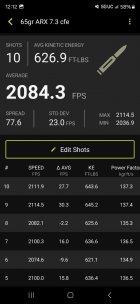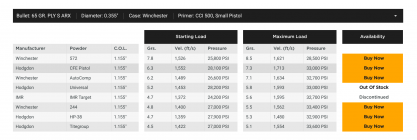I recently worked up a load from Hodgdon data for the 65gr Inceptor ARX projectile 9mm with CFE Pistol powder and tested it in my Ruger pistol caliber carbine 9mm through my chronograph. I am getting 350 FPS more velocity than the maximum load in the data with the same COL and amount of powder (7.3 grains CFE Pistol) which I attest to the barrel being 12 inches longer. The Ruger performed flawlessly with no signs of overpressure from the gun or the case and primer.
There are 7 other powders to choose from in the data for this projectile. What's interesting to me is of the 7, one powder at maximum load (Winchester 572) is 90 FPS slower, used 1.2 grains more, but is 4500 PSI less pressure (28500 PSI) than CFE Pistol (33,000 PSI) which I assume might have something to do with it being a slower burning powder according to the burn rate chart. I have read that slow burning powders can be ideal for longer barrels because the slower burn builds velocity as the projectile is exiting the barrel.
If I followed the data loading 572 to compare, how likely is it that I may see a gain in velocity greater than what I got from CFE Pistol due to the slower burning powder with a longer barrel? This interests me too because the lower pressure with 572 may afford to work up further than the published maximum load since the pressure is significantly lower, nearly 10,000 PSI less than +P loads (the Ruger PC Carbine is rated for +P). One thing to be cautious of is case capacity. The maximum load data with 572 is 8.5 grains. I do not want to compress the powder with the projectile. I do not know how much case capacity is left with 8.5 grains of 572 and don't want unforeseen pressure spikes.
There are 7 other powders to choose from in the data for this projectile. What's interesting to me is of the 7, one powder at maximum load (Winchester 572) is 90 FPS slower, used 1.2 grains more, but is 4500 PSI less pressure (28500 PSI) than CFE Pistol (33,000 PSI) which I assume might have something to do with it being a slower burning powder according to the burn rate chart. I have read that slow burning powders can be ideal for longer barrels because the slower burn builds velocity as the projectile is exiting the barrel.
If I followed the data loading 572 to compare, how likely is it that I may see a gain in velocity greater than what I got from CFE Pistol due to the slower burning powder with a longer barrel? This interests me too because the lower pressure with 572 may afford to work up further than the published maximum load since the pressure is significantly lower, nearly 10,000 PSI less than +P loads (the Ruger PC Carbine is rated for +P). One thing to be cautious of is case capacity. The maximum load data with 572 is 8.5 grains. I do not want to compress the powder with the projectile. I do not know how much case capacity is left with 8.5 grains of 572 and don't want unforeseen pressure spikes.












